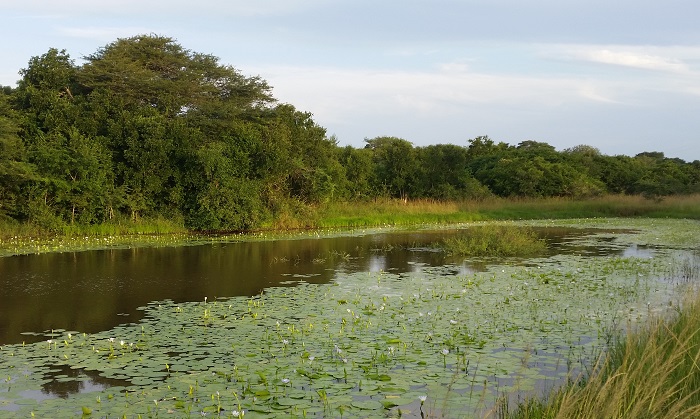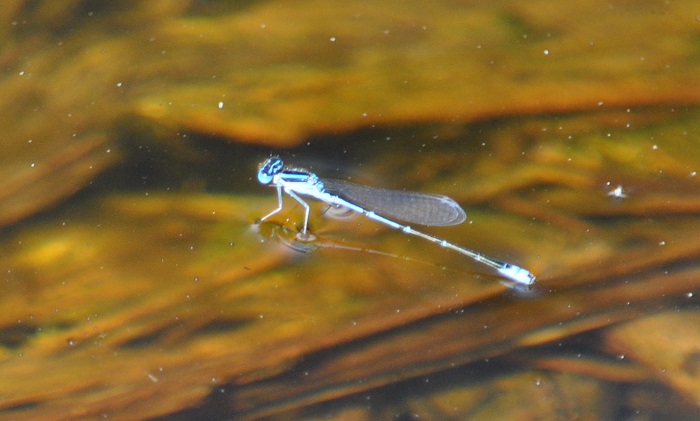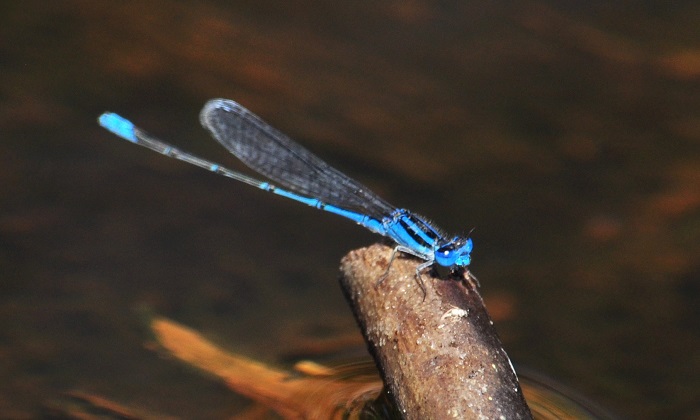Cover photo by Bernardine Altenroxel.
Find the Sailing Bluet in the FBIS database (Freshwater Biodiversity Information System) here.
Family Coenagrionidae
Identification
Very small size
Length up to 28mm; Wingspan attains 33mm.
The Sailing Bluet is often found alongside the Swamp Bluet (Africallagma glaucum), but is easily differentiated by its deeper blue colouration and by the black protrusion onto the eighth segment of the abdomen.
The females are similar to other Bluet females, and are best identified by their association with the males.
Click here for more details on identification.

Near Hluhluwe, KwaZulu-Natal
Photo by Ryan Tippett
Habitat
The Sailing Bluet frequents well-vegetated, still-water environments such as dams, ponds, marshes, and the quiet backwaters of rivers and streams. Azuragrion nigridorsum usually occupies areas with floating and emergent plants like waterlilies and sedges and is frequently found near floating mats of green algae.

Photo by Ryan Tippett
Behaviour
The Sailing Bluet is mostly found low down close to the water, where it perches on lily pads or emergent plants. The flight is fast and typically low over the water. When the weather is calm, the Sailing Bluet sometimes alights gently on the water without breaking the surface. They then drift across the pond in the breeze with their folded wings acting as sails (see image below). Females are often found in the same vicinity as the males.
The Sailing Bluet is primarily active from October to April but flies year-round at some sites. See Phenology below.

Near Hluhluwe, KwaZulu-Natal
Photo by Ryan Tippett
Status and Conservation
The sailing Bluet is a common and widespread species. It is listed as of Least Concern in the IUCN Red List of Threatened Species. Azuragrion nigridorsum is moderately sensitive to habitat damage, but has adapted well to man-made habitats and has doubtless benefited from this.

Near Hluhluwe, KwaZulu-Natal
Photo by Ryan Tippett
Distribution
Azuragrion nigridorsum is found from Ethiopia in the north, down through most of East and Southern Africa, including Angola and Zambia. In South Africa it is mostly absent from the dry central region.

Near Hluhluwe, KwaZulu-Natal
Photo by Ryan Tippett
Below is a map showing the distribution of records for Sailing Bluet in South Africa. Taken from the OdonataMAP database as at February 2020.

Below is a map showing the distribution of records for Sailing Bluet in South Africa. Taken from the OdonataMAP database as of December 2024.

The next map below is an imputed map, produced by an interpolation algorithm, which attempts to generate a full distribution map from the partial information in the map above. This map will be improved by the submission of records to the OdonataMAP section of the Virtual Museum.


Ultimately, we will produce a series of maps for all the odonata species in the region. The current algorithm is a new algorithm. The objective is mainly to produce “smoothed” maps that could go into a field guide for odonata. This basic version of the algorithm (as mapped above) does not make use of “explanatory variables” (e.g. altitude, terrain roughness, presence of freshwater — we will be producing maps that take these variables into account soon). Currently, it only makes use of the OdonataMAP records for the species being mapped, as well as all the other records of all other species. The basic maps are “optimistic” and will generally show ranges to be larger than what they probably are.
These maps use the data in the OdonataMAP section of the Virtual Museum, and also the database assembled by the previous JRS funded project, which was led by Professor Michael Samways and Dr KD Dijkstra.

Photo by Felicity Grundlingh
Phenology



Near Hluhluwe, KwaZulu-Natal
Photo by Ryan Tippett
Further Resources
The use of photographs by Bernardine Altenroxel and Felicity Grundlingh is acknowledged. Other photographs by Ryan Tippett.
Sailing Bluet Azuragrion nigridorsum (Selys, 1876)
Other common names: Black-tailed Bluet (Alt. English); Swartstertbloutjie (Afrikaans)
Recommended citation format: Loftie-Eaton M; Navarro R; Tippett RM; Underhill L. 2025. Sailing Bluet Azuragrion nigridorsum. Biodiversity and Development Institute. Available online at https://thebdi.org/2020/03/20/sailing-bluet-azuragrion-nigridorsum/
References: Tarboton, M; Tarboton, W. (2019). A Guide to the Dragonflies & Damselflies of South Africa. Struik Nature.
Samways, MJ. (2008). Dragonflies and Damselflies of South Africa. Pensoft
Samways, MJ. (2016). Manual of Freshwater Assessment for South Africa: Dragonfly Biotic Index. Suricata 2. South African National Biodiversity Institute, Pretoria
Martens, A; Suhling, F. (2007). Dragonflies and Damselflies of Namibia. Gamsberg Macmillan.

Near Hluhluwe, KwaZulu-Natal
Photo by Ryan Tippett

